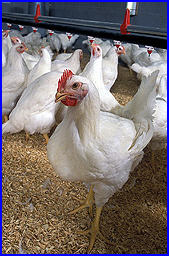



Testing Poultry Litter for No-Till Farming
US - Peter Kleinman plans to take his research on the road this fall. Every month or so, the Agricultural Research Service (ARS) soil scientist will leave the rolling valleys of Pennsylvania dairy country for corn, crabs and chicken—hallmarks of the Delmarva Peninsula. Soil scientist Peter Kleinman will investigate an experimental method of injecting chicken litter into soil to keep this natural fertilizer from running into the Chesapeake Bay. |
The 5,950-square-mile peninsula encompasses parts of Delaware, Maryland and Virginia. There, Kleinman will investigate an experimental method of injecting chicken litter into the soil to keep this natural fertilizer from running off into the Chesapeake Bay.
Each year, Delmarva's 2,700 or so poultry farms raise about 571,141,000 chickens. The 600,000 tons of litter they produce-a mixture of manure and bedding straw-is an ideal fertilizer for corn, soybeans and other Delmarva crops. However, spreading it over the soil surface exposes nutrients like phosphorus to runoff that can drain into the bay's surrounding waters, triggering algal blooms that block sunlight and deprive fish, crabs and other forms of aquatic life of oxygen.
The increasingly popular use of no-till farming compounds the problem, according to Kleinman, with the ARS Pasture Systems and Watershed Management Research Laboratory, University Park, Pa.
Since 2005, he has been researching fertilizer-application equipment called injectors, which squirt liquefied manure below the soil surface. Tom Way, a collaborator with the ARS Soil Dynamics Laboratory in Auburn, Ala., developed the new litter-injector technology. Now, in collaboration with the University of New Hampshire's Cooperative Institute for Coastal and Estuarine Environmental Technology (CICEET) and the National Oceanic and Atmospheric Administration, they're exploring equipment modifications that could enable the injection of chicken litter into the Delmarva Peninsula’s sandy soils.
Their on-site efforts will draw from prior research in which Kleinman and colleagues from ARS, The Pennsylvania State University and the University of Maryland-Eastern Shore used a combination of rainfall simulators, runoff monitoring technology and other equipment to examine how well four types of cow-manure injectors curbed runoff and odors emanating from fertilized fields. The project is one of 15 that CICEET is funding nationwide to foster new approaches to safeguarding America's coastal regions.
ThePoultrySite News Desk











